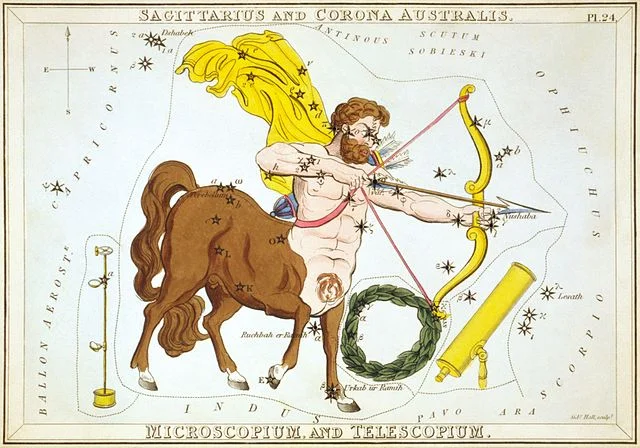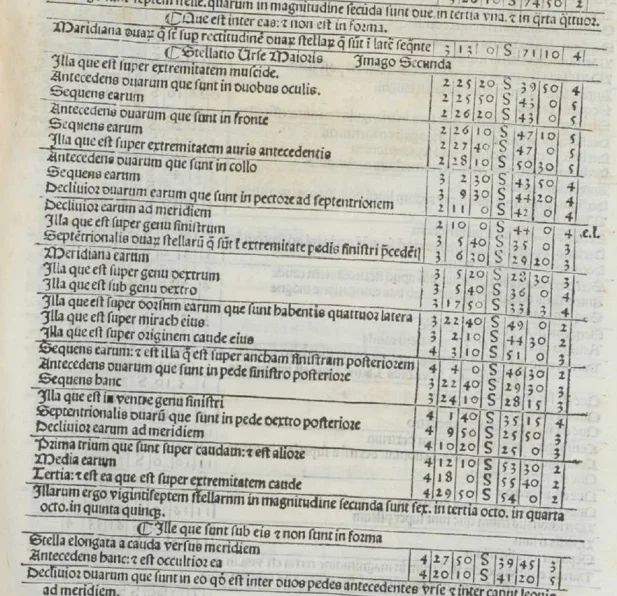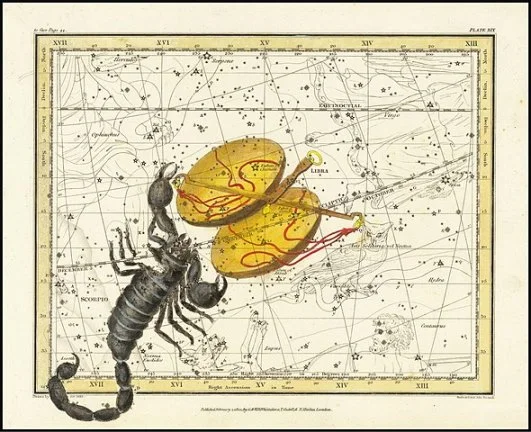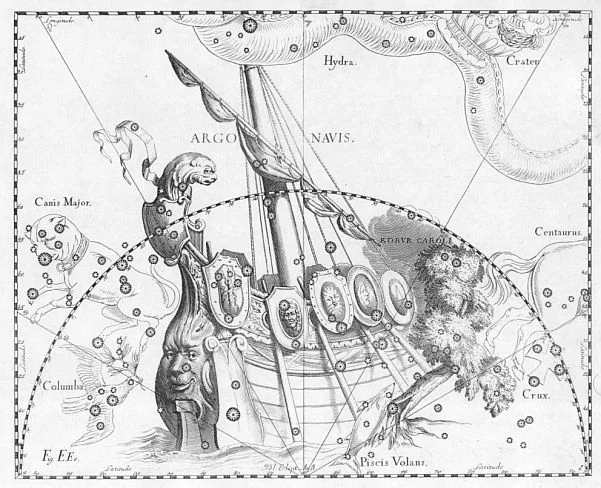Greek constellations are the 48 ancient constellations listed by the Greek astronomer Claudius Ptolemy in his Almagest in the 2nd century CE. All but one of these constellations have survived to the present day and are officially recognized by the International Astronomical Union (IAU). Most of them are associated with stories from Greek mythology.
Ptolemy identified the 12 constellations of the zodiac, 21 constellations north of the zodiac, and 15 constellations to the south. The modern versions of the 48 Greek constellations are not identical to those catalogued by Ptolemy (listed below), as these constellations had changed considerably over time before the official constellation boundaries were set in the early 20th century. Additionally, the definition of the term constellation has changed since antiquity. Once, it referred to an asterism formed by a constellation’s brightest stars. Now, constellations are defined as areas of the sky – not as star patterns – with borders clearly defined by the IAU. Ptolemy, as well as many who came after him, saw constellations as asterisms and identified stars by their position within them.
Ptolemy wrote the Almagest around 150 CE. The original manuscript, written in Greek, is long lost, but Arabic and Latin translations made Ptolemy’s treatise the most influential ancient text in the field of astronomy for more than a millennium. The Almagest is the most comprehensive surviving ancient astronomical treatise, one that served as a basic guide for European and Arabic astronomers until the 17th century. Many of the traditional star names that are still in use were derived from Arabic translations of Ptolemy’s descriptions of the stars’ positions.

Greek constellations Sagittarius and Corona Australis, plate 24 in Urania’s Mirror, a set of celestial cards accompanied by A familiar treatise on astronomy… by Jehoshaphat Aspin, 1825
Ptolemy’s constellations were quite different from the modern ones. For instance, the Greek astronomer catalogued only two stars in Canis Minor, while Centaurus included the stars of Crux. The constellation Eridanus ended at Acamar because Ptolemy, who made his observations from Alexandria, Egypt, could not see Achernar. Several stars belonged to two constellations. The star we know as Elnath, Beta Tauri, marked the right ankle of Auriga, the Charioteer, as well as the northern horn of Taurus, the Bull. Fomalhaut, Alpha Piscis Austrini, marked both the mouth of the Southern Fish (Piscis Austrinus) and the end of the water flow from the urn of Aquarius, the Water Bearer. Nu Boötis marked both the top of the Herdsman’s staff and the right foot of Hercules.
Ptolemy listed a total of 1,022 individual stars in Books VII and VIII of Almagest. The stars were described by their positions in the constellations and the brightest ones were marked m = 1 (first magnitude). The stars that were not assigned to constellations were called ἀμόρφωτοι (amorphotoi), or “unformed stars.” These were stars that were not part of distinct patterns. They have since been assigned to existing constellations or used to create new ones.

Ursa Major stars listed in a Latin translation of the Almagest
The asterisms that dominate the 48 Greek constellations were known long before Ptolemy. He was merely the first (known) astronomer to catalogue them, drawing on earlier works by Greek, Egyptian, Babylonian, and Assyrian astronomers. The star patterns themselves had already been recorded by earlier observers and some of the known depictions date back to prehistoric times. For instance, a depiction of Orion constellation found in a cave in Germany is estimated to be 32,000 to 38,000 years old. Taurus has been associated with a bull since the Chalcolithic, possibly even the Upper Paleolithic. The figure we know as Auriga was mentioned in the MUL.APIN, a Babylonian compendium compiled around 1000 BCE, a full millennium before Ptolemy.
The only constellation that was given a separate status by Ptolemy is Libra. Known as Χηλαί (Chelae, meaning “the pincers”) in Ptolemy’s time, Libra was part of the neighbouring constellation Scorpius. It represented the Scorpion’s claws. The names of its bright stars Zubeneschamali, Zubenelgenubi and Zubenelhakrabi were derived from Arabic phrases meaning “the northern claw,” the southern claw,” and “the claws of the Scorpion” respectively. Even though the Romans started associating the stars of what is now Libra with scales in the first century BCE, Ptolemy continued calling the constellation Chelae. The constellation’s association with balance did not begin with the Romans. It goes back to the Babylonians, who knew the constellation as ZIB.BA.AN.NA or “the balance of heaven” about a millennium before Ptolemy.

Scorpius and Libra, Alexander Jamieson, 1822
Not all modern constellation names are exact translations of the names given by Ptolemy. Pegasus, for instance, was simply known as “the horse,” while Equuleus was “the front part of the horse.” Hercules was “the kneeling man.” Cygnus was an unspecified “bird,” while Lupus was a “wild beast.” Canis Major was simply “the dog” and Canis Minor was known as Prokyon (“before the dog”). The name is now used for its brightest star, Procyon.
Even though the constellation now known as Coma Berenices was suggested by the Greek astronomer Hipparchus in the 2nd century BCE, it was not included on Ptolemy’s list.
The only Greek constellation that is not included among the 88 modern constellations is Argo Navis (the Ship Argo). In Ptolemy’s day and for many centuries that followed, Argo Navis was the largest constellation in the sky. It occupied much of the southern sky and represented Argo, the ship on which Jason and the Argonauts sailed on their quest to find the Golden Fleece. Argo Navis was used until 1930, when the IAU defined the borders of the modern constellations and formally divided Argo into three smaller constellations: Carina, representing the ship’s keel, Puppis, marking the stern, and Vela, outlining the sails. The division is attributed to the French astronomer Nicolas Louis de Lacaille, who designated the three portions of the constellation as “Argûs in carina”, “Argûs in puppi”, and “Argûs in velis” in his star atlas of 1763.

The constellation of Argo Navis from ‘Firmamentum Sobiescianum, sive Uranographia by Johannes Hevelius. The view is mirrored following the tradition of celestial globes, showing the celestial sphere in a view from “outside.”
Pyxis, a small constellation representing a mariner’s compass, introduced by Lacaille, is often taken to represent the compass of the ship, but it was not part of Argo Navis and is not a Greek constellation.
GREEK CONSTELLATIONS LIST
Below is the list the 48 Greek constellations, along with their original Greek names and numbers of stars and “unformed” stars, found outside the main constellation patterns.
| Andromeda | Ἀνδρομέδα | 23 |
| Aquarius | Ὑδροχόος | 42 + 3 |
| Aquila | Ἀετός | 9 + 6 |
| Ara | Θυμιατήριον | 7 |
| Argo Navis | Ἀργώ | 45 |
| Aries | Κριός | 13 + 5 |
| Auriga | Ἡνίοχος | 14 |
| Boötes | Βοώτης | 22 + 1 |
| Cancer | Καρκίνος | 9 + 4 |
| Canis Major | Κύων | 18 + 11 |
| Canis Minor | Προκύων | 2 |
| Capricornus | Αἰγόκερως | 28 |
| Cassiopeia | Κασσιέπεια | 13 |
| Centaurus | Κένταυρος | 37 |
| Cepheus | Κηφεύς | 11 + 2 |
| Cetus | Κῆτος | 22 |
| Corona Australis | Στέφανος νότιος | 13 |
| Corona Borealis | Στέφανος | 8 |
| Corvus | Κόραξ | 7 |
| Crater | Κρατήρ | 7 |
| Cygnus | Ὄρνις | 17 + 2 |
| Delphinus | Δελφίν | 10 |
| Draco | Δράκων | 31 |
| Equuleus | Ἵππου προτομή | 4 |
| Eridanus | Ποταμός | 34 |
| Gemini | Δίδυμοι | 18 + 17 |
| Hercules | Ἐνγόνασι | 28 + 1 |
| Hydra | Ὕδρος | 25 + 2 |
| Leo | Λέων | 27 + 8 |
| Lepus | Λαγωός | 12 |
| Libra | Χηλαί | 8 + 9 |
| Lupus | Θηρίον | 19 |
| Lyra | Λύρα | 10 |
| Ophiuchus | Ὀφιοῦχοςv | 24 + 5 |
| Orion | Ὠρίων | 38 |
| Pegasus | Ἵππος | 20 |
| Perseus | Περσεύς | 26 + 3 |
| Pisces | Ἰχθύες | 34 + 4 |
| Piscis Austrinus | Ἰχθύς νότιος | 11 + 6 |
| Sagitta | Ὀιστός | 5 |
| Sagittarius | Τοξότης | 31 |
| Scorpius | Σκορπίος | 21 + 3 |
| Serpens | Ὄφιςv | 18 |
| Taurus | Ταῦρος | 32 + 11 |
| Triangulum | Τρίγωνον | 4 |
| Ursa Major | Ἄρκτος μεγάλη | 27 + 8 |
| Ursa Minor | Ἄρκτος μικρά | 7 + 1 |
| Virgo | Παρθένος | 26 + 6 |
The data is from Ptolemy’s Almagest, via ianridpath.com.